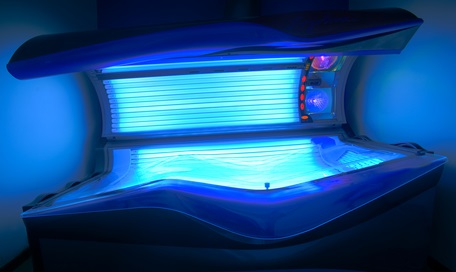SUMMARY: It is estimated that in the US, approximately 74,000 new cases of melanoma will be diagnosed and close to 10,000 individuals will die of the disease in 2015. The incidence of melanoma has been on the rise for the past three decades. A major risk factor for most skin cancers is exposure to UltraViolet (UV) radiation, which damages the DNA of skin cells. The main source of UV rays is sunlight, tanning lamps and tanning beds. The 3 main types of UV rays include UVA rays, UVB rays that mainly cause sunburns and UVC rays that do not penetrate through our atmosphere and are not in sunlight. Most indoor tanning beds give off large amounts of UVA rays, which have been found to increase skin cancer risk. It appears that there are no safe UV rays. The International Agency for Research on Cancer has classified Indoor tanning as a Class I carcinogen based on its significant association with malignant melanoma. Indoor tanning with resulting exposure to ultraviolet radiation is a potentially modifiable behavior and several studies to date have shown a relationship between indoor tanning and skin cancer. With this background, the authors reviewed the literature on indoor tanning and gathered data from 31 studies published in peer-reviewed journals that provided risk estimates. These studies included 14,956 cases with malignant melanoma and 233,106 controls. The main focus was to determine the risk of melanoma based on the frequency of use and exposure to the newer indoor tanning beds. They noted that among North Americans, there was a 34% increased risk of developing melanoma in individuals attending more than 10 tanning sessions. Further, those who started indoor tanning before age 25 years, had a 35% risk of developing melanoma and those who ever used indoor tanning were at a 23% increased risk of developing melanoma. It is hypothesized that the newer tanning bed bulb technology, which emits larger doses of long wave UVA rays, has resulted in a 22% increase in the risk of melanoma in individuals who ever used indoor tanning after the year 2000, compared to only 12% in the same population group before the year 2000. The authors concluded that the newer tanning technology is not safer than older techniques and patients should be educated and informed that using tanning beds can be associated with a subsequent diagnosis of malignant melanoma and therefore, cessation of indoor tanning should be strongly encouraged. Colantonio S, Bracken MB, Beecker J. J Am Acad Dermatol. 2014;70:847-857
The International Agency for Research on Cancer has classified Indoor tanning as a Class I carcinogen based on its significant association with malignant melanoma. Indoor tanning with resulting exposure to ultraviolet radiation is a potentially modifiable behavior and several studies to date have shown a relationship between indoor tanning and skin cancer. With this background, the authors reviewed the literature on indoor tanning and gathered data from 31 studies published in peer-reviewed journals that provided risk estimates. These studies included 14,956 cases with malignant melanoma and 233,106 controls. The main focus was to determine the risk of melanoma based on the frequency of use and exposure to the newer indoor tanning beds. They noted that among North Americans, there was a 34% increased risk of developing melanoma in individuals attending more than 10 tanning sessions. Further, those who started indoor tanning before age 25 years, had a 35% risk of developing melanoma and those who ever used indoor tanning were at a 23% increased risk of developing melanoma. It is hypothesized that the newer tanning bed bulb technology, which emits larger doses of long wave UVA rays, has resulted in a 22% increase in the risk of melanoma in individuals who ever used indoor tanning after the year 2000, compared to only 12% in the same population group before the year 2000. The authors concluded that the newer tanning technology is not safer than older techniques and patients should be educated and informed that using tanning beds can be associated with a subsequent diagnosis of malignant melanoma and therefore, cessation of indoor tanning should be strongly encouraged. Colantonio S, Bracken MB, Beecker J. J Am Acad Dermatol. 2014;70:847-857

